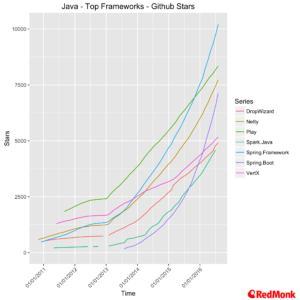 We had the opportunity to attend SpringOne Platform summit in Las Vegas in August. As my colleague James has already pointed out, this was a conference where significant Fortune 500 companies talked about the importance of developers. but not in the ‘oh we want to engage with developers because someone told us we should’ way, rather in a ‘we see the value of developers and technologists, and want to help them help us revolutionise our business’.
We had the opportunity to attend SpringOne Platform summit in Las Vegas in August. As my colleague James has already pointed out, this was a conference where significant Fortune 500 companies talked about the importance of developers. but not in the ‘oh we want to engage with developers because someone told us we should’ way, rather in a ‘we see the value of developers and technologists, and want to help them help us revolutionise our business’.
The disrupted are becoming the disrupters.
In the old model of enterprise technology was to outsource development and in source large chunks of IT operations (the IT department of old). The new model is to bring development back in-house and outsource all the parts with no differentiation.
Executives are finally getting the memo and have a growing understanding of what is strategically important from a technology standpoint for their business versus what is best left to others. Ultimately this comes down to understanding the possibilities of technology, and creating an environment in which change can happen at pace.
Customer Freedom
At any vendor event we are invariably offered the chance to meet with the vendor’s customers. It is a useful, and generally informative, way to get a somewhat different viewpoint on what the vendor is trying to focus on. The other key point to note with these customer meetings is that there is generally an analyst relations handler present, taking notes and to a lesser extent ensuring their customer doesn’t say anything wrong. As they might say in The Wire, it’s all part of the game.
What struck me once again at SpringOne Platform, as it has at some other recent events where I have spoken with Pivotal customers, is that this shepherding of the analyst and customer does not happen. There is a confidence within Pivotal about what their customers are doing that comes through. More importantly there is a freedom on the customer side to discuss things openly and acknowledge failures as well as successes – a point I will return to later.
Now that is not to say that we meet every customer of the company, and that some do not have difficulties. At these events we customers that have completely bought into the methodology and approach that Pivotal espouse – the Pivotal Way. These customers have invested in culture, pair programming, tooling and much more.
This is approach is not for everyone, and bluntly put not every organisation is a position to be able to adopt such an approach. Alongside this the near cult like devotion shown by Pivotal employees to the Pivotal Way can be quiet off putting for some. But for those that do buy in, completely, there are definite quantifiable results.
Cultural Change & Freedom to Fail
Much is written in all sorts of academic and business literature about the need for cultural change, business IT-alignment and so forth. The current trend we are seeing in many established enterprises can, unfortunately, be summed up as “rub some devops on it” – which completely misunderstands what needs to be done.
In reality there are some far more fundamental issues to be addressed at an organizational level in most companies. DevOps is a part, no doubt, as is technology. However, the leadership in most organisations need to develop a much higher level of digital literacy and a different understanding of risk. This ultimately comes down to how risk is managed, and giving people the freedom to fail, but within a context where it is possible to recover from it.
key point from @wattersjames – changing how we understand & manage risk in tech is a huge part of the transformation ahead of us #S1P 1/2
— Fintan Ryan (@fintanr) August 3, 2016
As we have already mentioned large enterprises are starting to get this. When executives from Citi, Bloomberg, Manulife, Allstate, Ford and others stand up and talk about the journey they are on, you know something is changing in the DNA of these companies.
Spring Framework & Spring Boot
In our recent analysis on the popularity of Java frameworks we noted the ongoing popularity of Spring Framework and the rise of Spring Boot. The growth in Spring Boot is very interesting, particularly as it expands into areas such as data pipelines with Spring Cloud Data Flow.
My colleague James puts it best when he says:
Spring Boot takes the concept of convention over configuration to its natural conclusion in the Java world
We were walked through the overall roadmap for Spring, which is as you might expect it is all going in a positive direction. One set of pointed comments about the direction of the JDK particularly stood out.
Slips in, and poor communication about, the jdk 9 schedule rightly highlighted in @springframework keynote #S1P https://t.co/N11IUsDyO6
— Fintan Ryan (@fintanr) August 3, 2016
In the case of Spring, people are no longer willing to wait for a schedule they can see has clearly been missed. The world has to move on, and it is becoming increasingly clear that all of the communities’ dependent on Java will move on, with or without Oracles help.
Security, Security, Security
One of the most interesting talks on an operational front over the conference was from Justin Smith, where he talked about cloud native security. Part of the overall cultural change we referred to above is understanding that change is both necessary and welcome, and this also includes your infrastructure.
At the same time in our conversations with enterprises we still frequently hear of the infamous update window, where a change board approved set of system level patches will be rolled out, and your infrastructure will be certified as being in compliance once more. As Justin rightly points out this approach is not sustainable in the longer term. The threat landscape has evolved, as has our approach to software development.
This leads to an interesting question:
how can a security strategy which resists change keep up with the pace of the modern threat landscape?
The solution proposed, to have rolling rebuilds of your infrastructure, simplified as repave, repair, rotate is an interesting approach that definitely merits a look.
Disclaimers: Pivotal paid my T&E. Pivotal and Oracle are current RedMonk customers.

No Comments